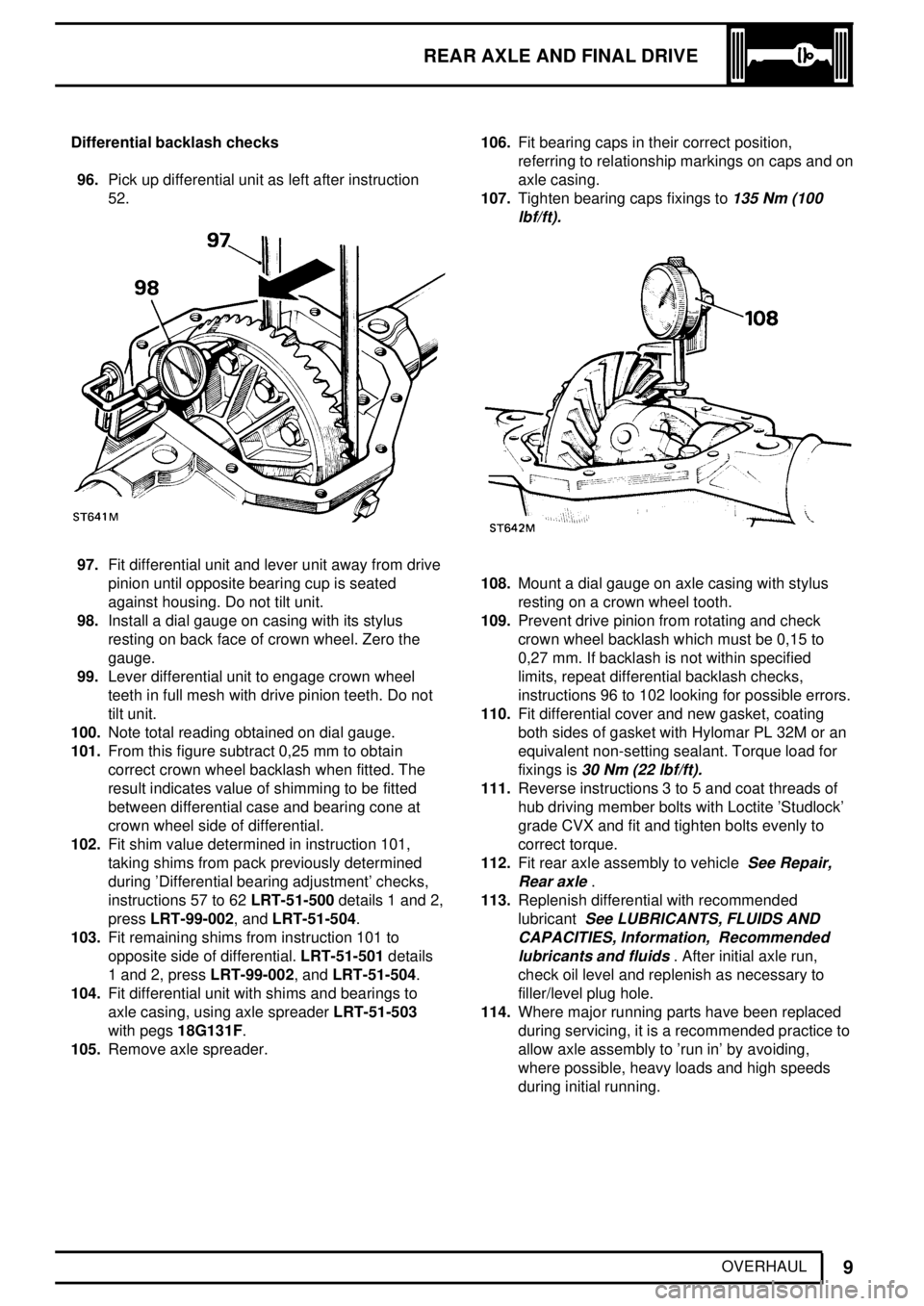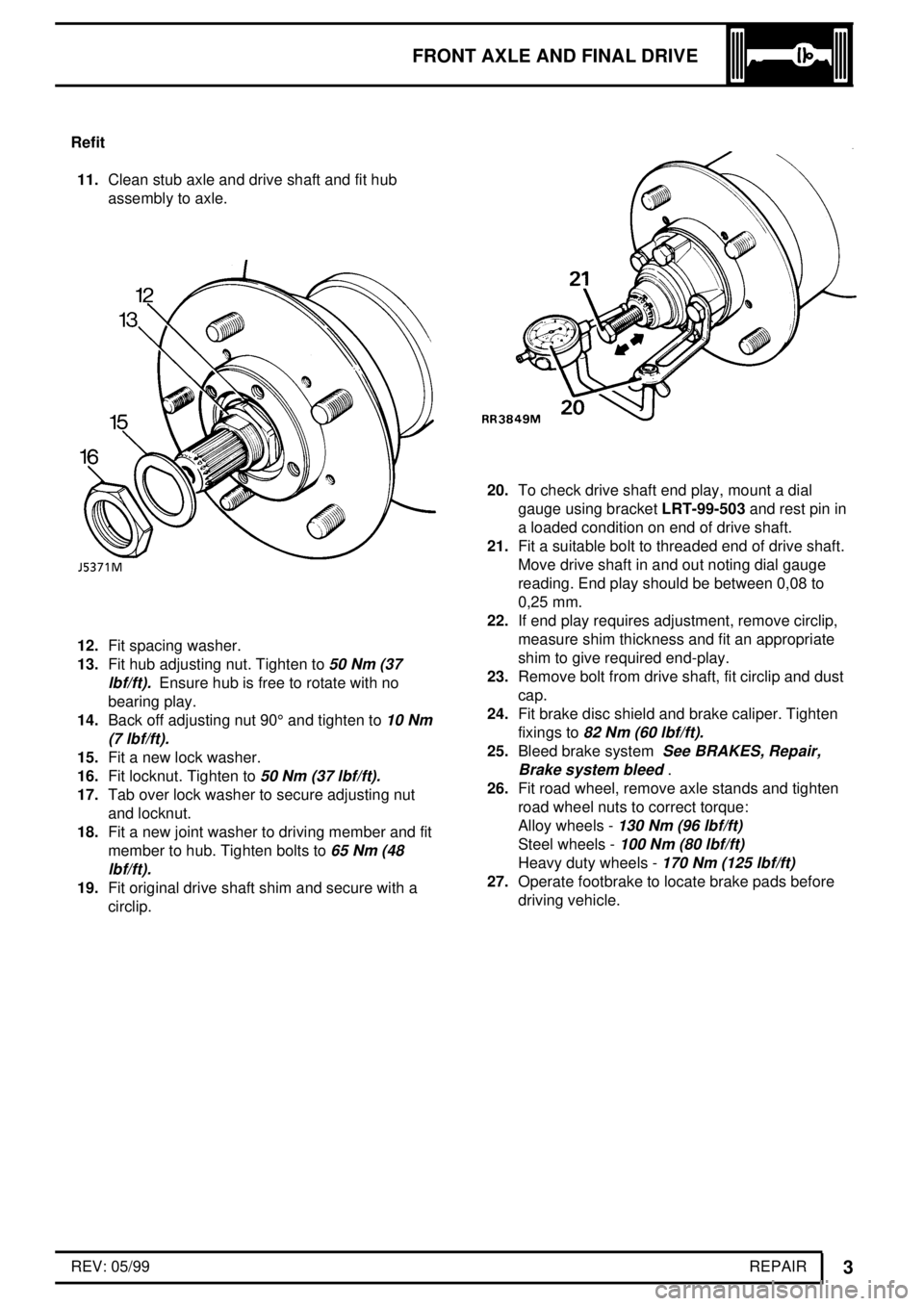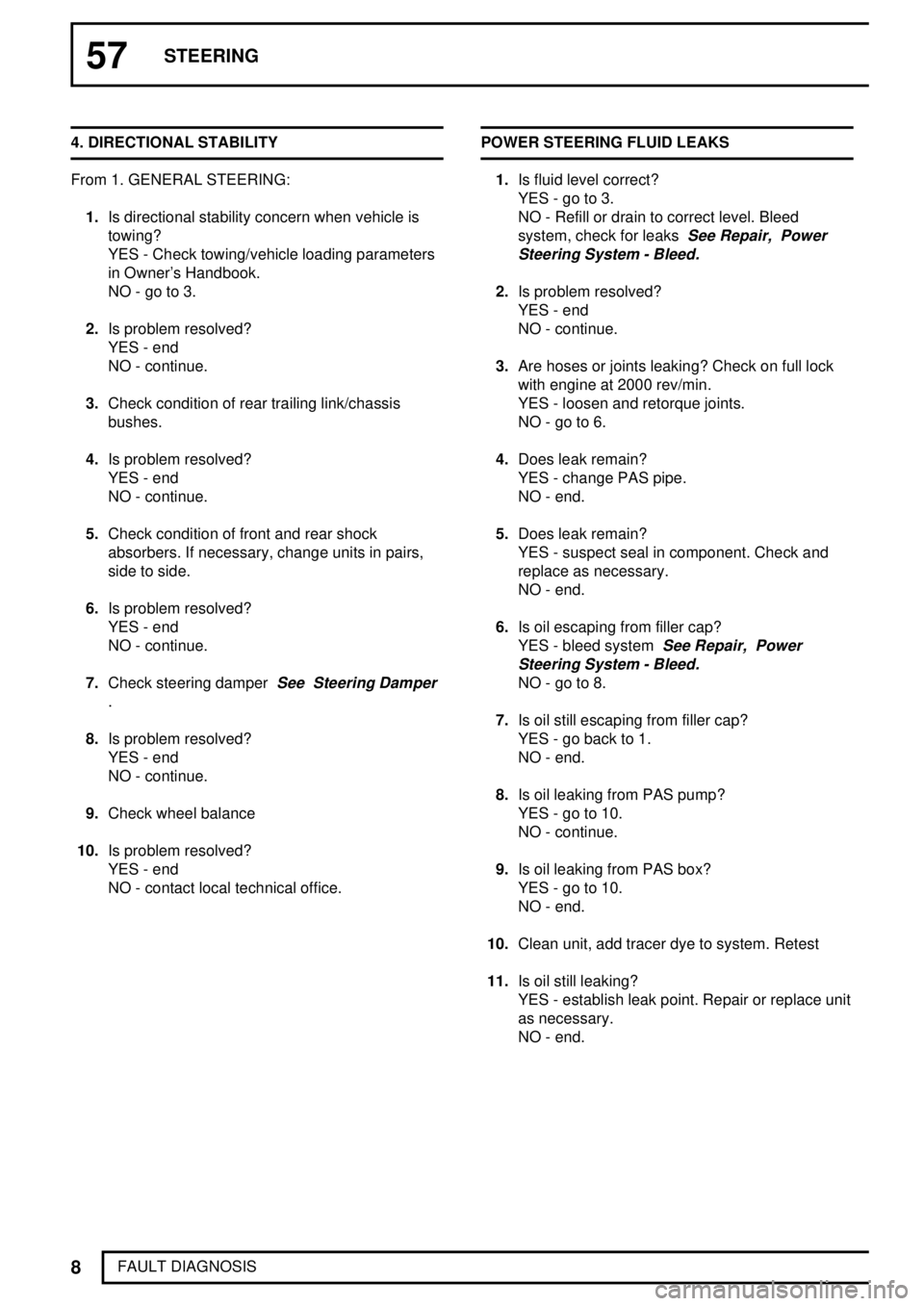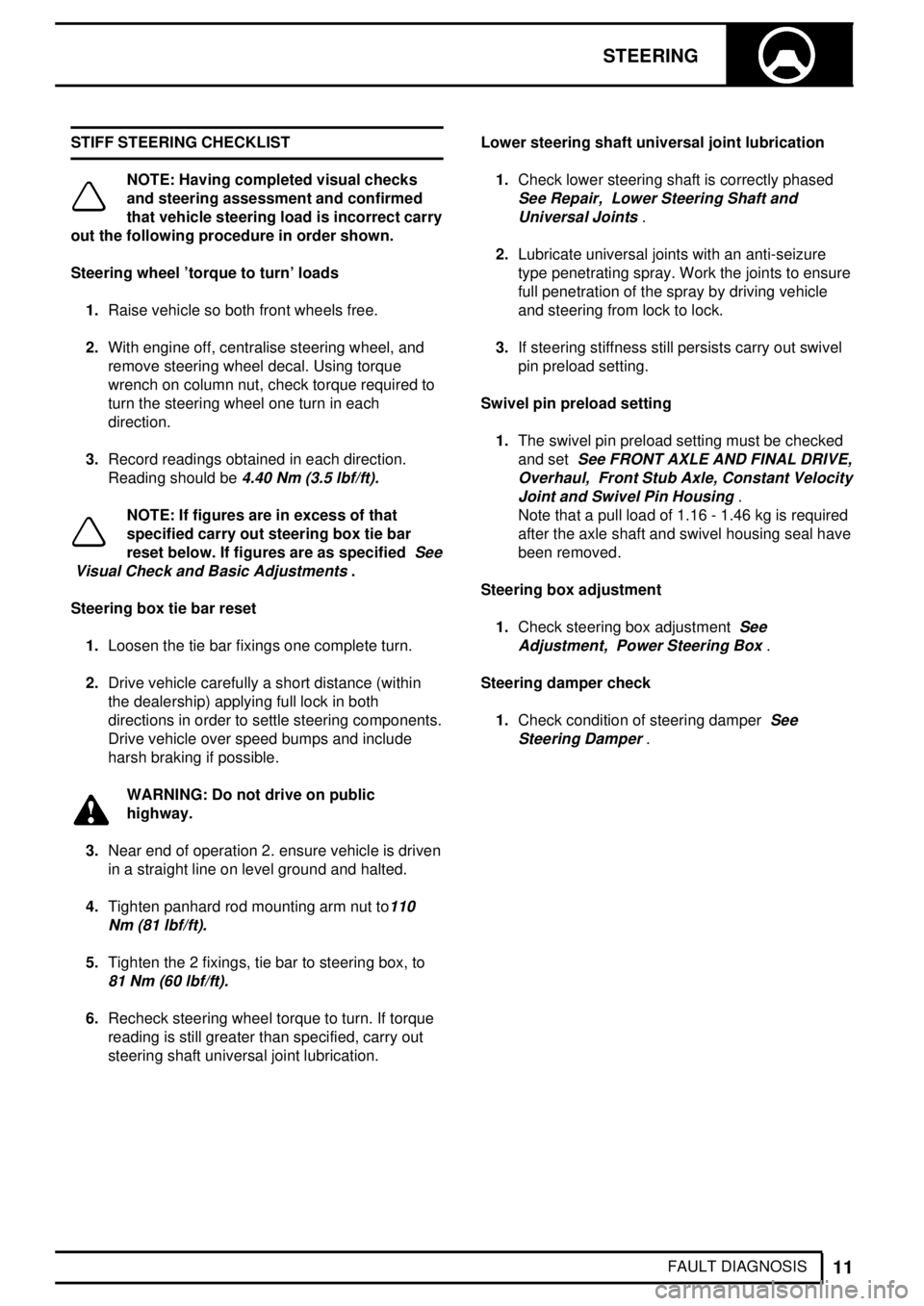torque LAND ROVER DEFENDER 1996 Owner's Manual
[x] Cancel search | Manufacturer: LAND ROVER, Model Year: 1996, Model line: DEFENDER, Model: LAND ROVER DEFENDER 1996Pages: 455, PDF Size: 6.44 MB
Page 195 of 455

51REAR AXLE AND FINAL DRIVE
6
OVERHAUL
70.Press inner bearing cone onto drive pinion using,
LRT-51-502details 1 and 2 and press
LRT-99-002.
71.Position pinion and bearing in casing; omit
collapsable spacer at this stage.
72.Fit outer bearing cone onto pinion.
73.Fit coupling flange and plain washer and loosely
fit flange nut.
74.Tighten coupling flange locknut to remove
end-float from pinion.
75.Rotate pinion to settle bearings and slowly
tighten flange locknut. Use a spring balance to
obtain a torque resistance of 11 Kgf/cm (18
lbf/in) to rotate pinion.
Drive pinion markings
76.Check that serial number marked on pinion end
face matches that marked on crown wheel.
77.The markings on end face adjacent to serial
number are of no significance during servicing.
78.The figure marked on end face opposite to serial
number indicates, in thousandths of an inch,
deviation from nominal required to correctly set
pinion. A pinion marked plus (+) must be set
below nominal, a minus (-) pinion must be set
above nominal. An unmarked pinion must be set
at nominal.
79.The nominal setting dimension is represented by
setting gauge block18G191PorLRT-54-503,
which is referenced from pinion end face to
bottom radius of differential bearing bore. The
latter gauge is illustrated following instruction 85.
Drive pinion adjustment
80.Ensure that pinion end face is free of raised
burrs around etched markings.
81.Remove keep disc from magnetized base of dial
gauge tool18G191.
82.Place dial gauge and setting gauge18G191Por
LRT-54-503on a flat surface and zero dial
gauge stylus on to setting gauge.
Page 197 of 455

51REAR AXLE AND FINAL DRIVE
8
OVERHAUL 86.Before adjusting shim thickness, check pinion
face marking and if it has a plus (+) figure,
subtract that from shim thickness figure obtained
in previous instruction. Alternatively if pinion has
a minus (-) figure, add amount to shim thickness
figure.
87.Adjust shim thickness under pinion inner cup as
necessary, by amount determined in instructions
85 and 86.
88.Recheck pinion height setting instructions 82 to
84. If setting is correct, mean reading on dial
gauge will agree with figure marked on pinion
end face. For example, with an end face marking
of +3, dial gauge reading should indicate that
pinion is 0.003 in (0.0762 mm) below nominal.
89.When pinion setting is satisfactory, temporarily
remove pinion outer bearing.
90.Fit a new collapsable bearing spacer, flared end
outward, to drive pinion and refit outer bearing.
91.Fit pinion oil slinger.
92.Fit oil seal gasket.
93.Fit pinion oil seal, lipped side first, using general
purpose grease or, where available, a
molybdenum disulphide based grease on seal
lip, usingLRT-51-002to drift in seal.
94.Fit coupling flange and plain washer and loosely
fit a new flange nut. SecureLRT-51-003to
coupling flange, using slave fixings.
95.Alternately tighten flange nut and check drive
pinion resistance to rotation until following
figures are achieved, as applicable:
A.Assemblies re-using original pinion bearings:
17,3 to 34,5 kgf cm.
B.Assemblies with new pinion bearings: 34,5 to
46,0 kgf cm.
NOTE: Once the bearing spacer has
started to collapse the torque resistance
build-up is rapid, therefore check
frequently, using a spring balance, to ensure the
correct figures are not exceeded, otherwise a new
collapsable bearing spacer will be required.
Page 198 of 455

REAR AXLE AND FINAL DRIVE
9
OVERHAUL Differential backlash checks
96.Pick up differential unit as left after instruction
52.
97.Fit differential unit and lever unit away from drive
pinion until opposite bearing cup is seated
against housing. Do not tilt unit.
98.Install a dial gauge on casing with its stylus
resting on back face of crown wheel. Zero the
gauge.
99.Lever differential unit to engage crown wheel
teeth in full mesh with drive pinion teeth. Do not
tilt unit.
100.Note total reading obtained on dial gauge.
101.From this figure subtract 0,25 mm to obtain
correct crown wheel backlash when fitted. The
result indicates value of shimming to be fitted
between differential case and bearing cone at
crown wheel side of differential.
102.Fit shim value determined in instruction 101,
taking shims from pack previously determined
during 'Differential bearing adjustment' checks,
instructions 57 to 62LRT-51-500details 1 and 2,
pressLRT-99-002, andLRT-51-504.
103.Fit remaining shims from instruction 101 to
opposite side of differential.LRT-51-501details
1 and 2, pressLRT-99-002, andLRT-51-504.
104.Fit differential unit with shims and bearings to
axle casing, using axle spreaderLRT-51-503
with pegs18G131F.
105.Remove axle spreader.106.Fit bearing caps in their correct position,
referring to relationship markings on caps and on
axle casing.
107.Tighten bearing caps fixings to
135 Nm (100
lbf/ft).
108.Mount a dial gauge on axle casing with stylus
resting on a crown wheel tooth.
109.Prevent drive pinion from rotating and check
crown wheel backlash which must be 0,15 to
0,27 mm. If backlash is not within specified
limits, repeat differential backlash checks,
instructions 96 to 102 looking for possible errors.
110.Fit differential cover and new gasket, coating
both sides of gasket with Hylomar PL 32M or an
equivalent non-setting sealant. Torque load for
fixings is
30 Nm (22 lbf/ft).
111.Reverse instructions 3 to 5 and coat threads of
hub driving member bolts with Loctite 'Studlock'
grade CVX and fit and tighten bolts evenly to
correct torque.
112.Fit rear axle assembly to vehicle
See Repair,
Rear axle
.
113.Replenish differential with recommended
lubricant
See LUBRICANTS, FLUIDS AND
CAPACITIES, Information, Recommended
lubricants and fluids
. After initial axle run,
check oil level and replenish as necessary to
filler/level plug hole.
114.Where major running parts have been replaced
during servicing, it is a recommended practice to
allow axle assembly to 'run in' by avoiding,
where possible, heavy loads and high speeds
during initial running.
Page 205 of 455

REAR AXLE AND FINAL DRIVE
1
SPECIFICATIONS, TORQUE REV: 05/99 TORQUE VALUES
NOTE: Torque wrenches should be regularly checked for accuracy to ensure that all fixings are
tightened to the correct torque.
Nm
REAR AXLE
Pinion housing to axle case 41.......................................................................
Crown wheel to differential case 58................................................................
Differential bearing cap to pinion housing 90..................................................
Differential drive flange to drive shaft 47.........................................................
Bevel pinion nut 129........................................................................................
Lower link to axle 176......................................................................................
Pivot bracket ball joint to axle 176...................................................................
Page 209 of 455

FRONT AXLE AND FINAL DRIVE
1
REPAIR REV: 05/99 FRONT AXLE ASSEMBLY
Service repair no - 54.10.01
Remove
WARNING: Remove and refit of axle
requires a further two persons to steady
axle when lowering or repositioning axle.
1.Support chassis front.
2.Remove road wheels.
3.Support axle weight with hydraulic jack.
4.Remove radius arms to chassis frame nuts.
5.Disconnect steering damper from track rod.
Using a extractor remove track rod links from
swivel pin arms.
6.Remove four nuts and bolts securing radius
arms to axle bracket.
7.Remove radius arms.
8.Remove bolts securing brake hose brackets .
Refit bolts to prevent oil leakage.
9.Remove bolts from brake calipers and tie to one
side.
10.Remove nuts and washers securing shock
absorbers to axle.
11.Disconnect drag link from swivel pin housing
arm.
12.Remove two nuts and bolts securing panhard
rod to axle bracket. Lift rod clear of axle.
13.Mark for reassembly drive shaft flanges.
Remove four nuts and bolts, tie propeller shaft to
one side.
14.Release axle ventilation pipe banjo and lower
axle assembly. Remove road springs.
15.Disconnect anti-roll bar link
See FRONT
SUSPENSION, Repair, Anti-roll bar ball
.
16.Remove axle assembly.
Refit
17.Position axle under vehicle, supporting left side
of axle, and fit anti-roll bar links
See FRONT
SUSPENSION, Repair, Anti-roll bar links
.
18.Fit propeller shaft. Tighten bolts to
47 Nm (35
lbf/ft).
19.Fit panhard rod to axle bracket. Tighten bolts to
88 Nm (65 lbf/ft).
20.Fit drag link to swivel pin arm. Tighten fixings to
40 Nm (30 lbf/ft).
21.Fit shock absorbers to axle.
22.Fit brake calipers. Tighten bolts to
82 Nm (60
lbf/ft).
23.Tighten upper swivel pin bolts to78 Nm (58
lbf/ft).
24.Fit radius arms to axle brackets. Tighten bolts to
197 Nm (145 lbf/ft).
25.Fit steering damper to track rod.
26.Fit radius arms to chassis side member. Tighten
fixings to
197 Nm (145 lbf/ft).
27.Tighten track rod end to40 Nm (30 lbf/ft)and fit
new split pin.
28.Remove chassis supports, fit road wheels and
tighten to correct torque:
Alloy wheels -
130 Nm (96 lbf/ft)
Steel wheels -100 Nm (80 lbf/ft)
Heavy duty wheels -170 Nm (125 lbf/ft)
Page 211 of 455

FRONT AXLE AND FINAL DRIVE
3
REPAIR REV: 05/99 Refit
11.Clean stub axle and drive shaft and fit hub
assembly to axle.
12.Fit spacing washer.
13.Fit hub adjusting nut. Tighten to
50 Nm (37
lbf/ft).
Ensure hub is free to rotate with no
bearing play.
14.Back off adjusting nut 90°and tighten to
10 Nm
(7 lbf/ft).
15.Fit a new lock washer.
16.Fit locknut. Tighten to
50 Nm (37 lbf/ft).
17.Tab over lock washer to secure adjusting nut
and locknut.
18.Fit a new joint washer to driving member and fit
member to hub. Tighten bolts to
65 Nm (48
lbf/ft).
19.Fit original drive shaft shim and secure with a
circlip.
20.To check drive shaft end play, mount a dial
gauge using bracketLRT-99-503and rest pin in
a loaded condition on end of drive shaft.
21.Fit a suitable bolt to threaded end of drive shaft.
Move drive shaft in and out noting dial gauge
reading. End play should be between 0,08 to
0,25 mm.
22.If end play requires adjustment, remove circlip,
measure shim thickness and fit an appropriate
shim to give required end-play.
23.Remove bolt from drive shaft, fit circlip and dust
cap.
24.Fit brake disc shield and brake caliper. Tighten
fixings to
82 Nm (60 lbf/ft).
25.Bleed brake systemSee BRAKES, Repair,
Brake system bleed
.
26.Fit road wheel, remove axle stands and tighten
road wheel nuts to correct torque:
Alloy wheels -
130 Nm (96 lbf/ft)
Steel wheels -100 Nm (80 lbf/ft)
Heavy duty wheels -170 Nm (125 lbf/ft)
27.Operate footbrake to locate brake pads before
driving vehicle.
Page 217 of 455

FRONT AXLE AND FINAL DRIVE
1
SPECIFICATIONS, TORQUE REV: 05/99 TORQUE VALUES
NOTE: Torque wrenches should be regularly checked for accuracy to ensure that all fixings are
tightened to the correct torque.
Nm
FRONT AXLE
Hub driving member to hub 65*.......................................................................
Brake disc to hub 73.......................................................................................
Stub axle to swivel pin housing 65*.................................................................
Brake caliper to swivel pin housing 82............................................................
Upper swivel pin to swivel pin housing 78*.....................................................
Lower swivel pin to swivel pin housing 78*.....................................................
Oil seal retainer to swivel pin housing 11........................................................
Swivel bearing housing to axle case 73*.........................................................
Pinion housing to axle case 41.......................................................................
Crown wheel to differential housing 58...........................................................
Differential bearing cap to pinion housing 90..................................................
Differential drive flange to drive shaft 47.........................................................
Mudshield to bracket lower swivel pin 11........................................................
Bevel pinion nut 130........................................................................................
Draglink to hub arm 40....................................................................................
Panhard rod to axle bracket 88.......................................................................
Radius arm to axle 190....................................................................................
Radius arm to chassis side member 190.........................................................
NOTE: * These bolts to be coated with Loctite 270 prior to assembly.
Page 227 of 455

STEERING
5
FAULT DIAGNOSIS REV: 05/99 Symptom :-
Steering excessively light/sensitive. Excessive
freeplay at steering wheel.
1.Are steering box adjustments correct?
NO -
See Adjustment, Power Steering Box.
WARNING: Adjustments of steering box
should not be required while in warranty
period. If box is within warranty, it must be
returned to manufacturer. No attempt must be
made to introduce backlash.
YES - Suspect worn panhard rod or radius arm
bushes. Check condition of ball joints and the
lower steering column shaft universal joints for
wear
See Repair, Lower Steering Shaft and
Universal Joints
.
Symptom :-
Steering vibration, road wheel shimmy - wobble.
Vibration through the steering linkage powerful
enough to induce high frequency oscillation of the
steering wheel, is generally caused by out of balance
road wheels. However there are a number of other
possible causes of this symptom which if severe, may
be described as shimmy or wobble. Regardless of the
terminology used by the owner/driver to describe the
symptoms, the following diagnostic checks should be
carried out in the order presented.
1.Check the tyres and balance of the road wheels
See GENERAL SPECIFICATION DATA,
Information, Wheels and Tyres
,See
WHEELS AND TYRES, Fault diagnosis, Fault
- Symptoms See WHEELS AND TYRES,
Repair, Wheel Balancing .
2.Check the steering hydraulic damper function
See Steering Damper.
3.Check steering column universal joints for wear
and correct alignment
See Repair, Lower
Steering Shaft and Universal Joints
.4.Check steering linkage ball joints for wear,
correct alignment and security, including steering
box and tie rod
See Steering Linkage Inspect
.
5.Check all front suspension rubbers for wear.
Check all fixing torques, including radius arm
bushes, panhard rod and anti-roll bar
See
FRONT SUSPENSION, Repair, Panhard Rod
,
See FRONT SUSPENSION, Repair, Radius
Arm
,See FRONT SUSPENSION, Repair,
Anti-Roll Bar
,See FRONT SUSPENSION,
Repair, Front Shock Absorber
.
6.Fit new radius arm bushes using NTC 6781. Fit
new nuts, bolts and washers.
7.If problem persists fit damper kit STC 288 - 90,
STC 290 - 110/130 (2 off front) and STC 289 -
90, STC 291 - 110 levelled, STC 292 - 110
unlevelled, STC 293 - 130 (2 off rear). Road test
vehicle.
8.Check the power steering box adjustments and
operation
See Overhaul, Power Steering Box.
9.Check the hub bearing end floats and determine
the condition of the hub bearings as applicable
See FRONT AXLE AND FINAL DRIVE, Repair,
Front Hub Assembly
.
10.Check the resistance and condition of the
swivels
See FRONT AXLE AND FINAL DRIVE,
Description and operation, Description
.
If problem is not diagnosed: Repeat checks
starting at 1.
11.Carry out a full steering geometry check
See
GENERAL SPECIFICATION DATA,
Information, Steering
.
Page 230 of 455

57STEERING
8
FAULT DIAGNOSIS 4. DIRECTIONAL STABILITY
From 1. GENERAL STEERING:
1.Is directional stability concern when vehicle is
towing?
YES - Check towing/vehicle loading parameters
in Owner's Handbook.
NO - go to 3.
2.Is problem resolved?
YES - end
NO - continue.
3.Check condition of rear trailing link/chassis
bushes.
4.Is problem resolved?
YES - end
NO - continue.
5.Check condition of front and rear shock
absorbers. If necessary, change units in pairs,
side to side.
6.Is problem resolved?
YES - end
NO - continue.
7.Check steering damper
See Steering Damper
.
8.Is problem resolved?
YES - end
NO - continue.
9.Check wheel balance
10.Is problem resolved?
YES - end
NO - contact local technical office.POWER STEERING FLUID LEAKS
1.Is fluid level correct?
YES - go to 3.
NO - Refill or drain to correct level. Bleed
system, check for leaks
See Repair, Power
Steering System - Bleed.
2.Is problem resolved?
YES - end
NO - continue.
3.Are hoses or joints leaking? Check on full lock
with engine at 2000 rev/min.
YES - loosen and retorque joints.
NO - go to 6.
4.Does leak remain?
YES - change PAS pipe.
NO - end.
5.Does leak remain?
YES - suspect seal in component. Check and
replace as necessary.
NO - end.
6.Is oil escaping from filler cap?
YES - bleed system
See Repair, Power
Steering System - Bleed.
NO - go to 8.
7.Is oil still escaping from filler cap?
YES - go back to 1.
NO - end.
8.Is oil leaking from PAS pump?
YES - go to 10.
NO - continue.
9.Is oil leaking from PAS box?
YES - go to 10.
NO - end.
10.Clean unit, add tracer dye to system. Retest
11.Is oil still leaking?
YES - establish leak point. Repair or replace unit
as necessary.
NO - end.
Page 233 of 455

STEERING
11
FAULT DIAGNOSIS STIFF STEERING CHECKLIST
NOTE: Having completed visual checks
and steering assessment and confirmed
that vehicle steering load is incorrect carry
out the following procedure in order shown.
Steering wheel 'torque to turn' loads
1.Raise vehicle so both front wheels free.
2.With engine off, centralise steering wheel, and
remove steering wheel decal. Using torque
wrench on column nut, check torque required to
turn the steering wheel one turn in each
direction.
3.Record readings obtained in each direction.
Reading should be
4.40 Nm (3.5 lbf/ft).
NOTE: If figures are in excess of that
specified carry out steering box tie bar
reset below. If figures are as specified
See
Visual Check and Basic Adjustments
.
Steering box tie bar reset
1.Loosen the tie bar fixings one complete turn.
2.Drive vehicle carefully a short distance (within
the dealership) applying full lock in both
directions in order to settle steering components.
Drive vehicle over speed bumps and include
harsh braking if possible.
WARNING: Do not drive on public
highway.
3.Near end of operation 2. ensure vehicle is driven
in a straight line on level ground and halted.
4.Tighten panhard rod mounting arm nut to
110
Nm (81 lbf/ft).
5.Tighten the 2 fixings, tie bar to steering box, to
81 Nm (60 lbf/ft).
6.Recheck steering wheel torque to turn. If torque
reading is still greater than specified, carry out
steering shaft universal joint lubrication.Lower steering shaft universal joint lubrication
1.Check lower steering shaft is correctly phased
See Repair, Lower Steering Shaft and
Universal Joints
.
2.Lubricate universal joints with an anti-seizure
type penetrating spray. Work the joints to ensure
full penetration of the spray by driving vehicle
and steering from lock to lock.
3.If steering stiffness still persists carry out swivel
pin preload setting.
Swivel pin preload setting
1.The swivel pin preload setting must be checked
and set
See FRONT AXLE AND FINAL DRIVE,
Overhaul, Front Stub Axle, Constant Velocity
Joint and Swivel Pin Housing
.
Note that a pull load of 1.16 - 1.46 kg is required
after the axle shaft and swivel housing seal have
been removed.
Steering box adjustment
1.Check steering box adjustment
See
Adjustment, Power Steering Box
.
Steering damper check
1.Check condition of steering damper
See
Steering Damper
.